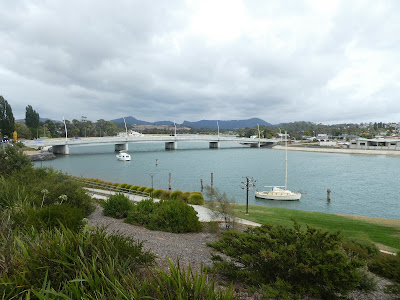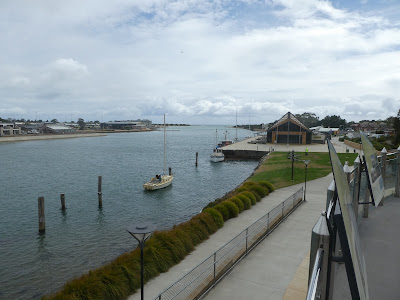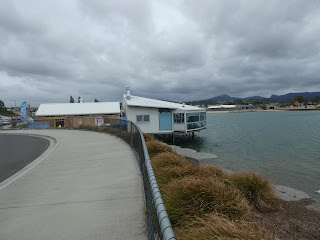Yes, I know....."we'll catch up with Ulverstone next time", he said. Well, having again revisited the many photos we took during a quick roam through this interesting town, I have decided to present a brief snapshot of the CBD, the waterfront and a fascinating park,
beginning with a shot of the quite modern road bridge over the broad Leven River estuary which is a real feature of Ulverstone.
Needless to say, commercial interests have taken up spots along the banks.
Waterfront cafes and restaurants overlook the river,
ranging in style from a good old fish and chippo here at Pedro The Fisherman,
to fine dining, in this instance right over the water.
As could be expected, this area is complemented by a good open public park with picnic tables and brollies, although, as you can see, on the day of our visit the weather did not encourage any to be sitting outdoors munching on a sandwich or sipping from a flask of coffee.
On the opposite bank we could see the small boat ramp and large buildings indicative of marine industries.
Ulverstone, with a population of over 6,000, is a large town by Tasmanian standards. The origins of its name remain clouded, but those in the know place their money on the story that it was copied from the English 'Ulverston' which also lies on the UK's River Leven. That will do me!
Like other towns on the north coast, Ulverstone initially came into existence when timber cutters moved into the area to supply the insatiable demand for split timber on the Victorian goldfields in the late 1800's. During this time the quality of the soil and its suitability for growing vegetables was recognised, and today agriculture plays a very significant part in the local economy.
Potatoes, onions and cherries thrive in the area and the large Perfecta Produce plant, which produces the well known Blue Banner brand of pickled onions (amongst many other products such as cut potato chips etc) employs many locals.
We continued our ramble north past the waterfront park area en route to one of Ulverstone's most notable features, its Navy Park.
On this aerial shot of the town, thanks to 'explore australia' I've marked the bridge with blue, the park we were about to visit in yellow, whilst the red arrow shows the location of the incredible memorial tower at the head of the CBD's main street.
This sign at the park entrance gave us our first clue as to the genesis of the this unexpected find.
This was the sort of venture I would have more likely expected to find in a much larger city or town, but as you can see, the bloke who devised and pushed the project was a local, and he was clearly a man on a mission. It obviously helped that he held the position he did after the war!
Occupying a prime hunk of real estate right at the mouth of the Leven River, this park is just dotted with memorials and other oddities. I have made what I hope is an indicative selection.
Whilst the park was initially dedicated to the 1,000 officers and men of HMAS Shropshire, it now houses memorials to all manner of naval vessels, both individually and by class.
An information board on the Shropshire memorial told us more of the story.
As we wandered about, it struck us just how remarkable it was that a park of this size could be found in a town like Ulverstone, a place with no direct naval connections other than ex- crewmen living here.
The memorials were varied. Here, for example,

the name of various ships and their battle honours were emblazoned on brass plaques.

The corvette fleet was remembered in a completely different manner.

Amongst all the serious stuff, the navy sense of humour prevailed throughout. Here at 'Otto's Grotto' where the shelter shed and BBQ area in the background was fitting named 'Fleet's Inn'

we came across Otto's 'Revenue of Trees'. There just had to be a story here,
and there was.

What a character he must have been!

And on a completely different tack, here at Man O' War Steps

we have the story of 'Nuff-Nuff'!
These were but a few of the many exhibits, memorials and odd little shrines which were to be found throughout this 'park of many parts' which, to me at least, married solemn remembrance with instances of the type of humour which allowed so many to survive the horrors of war. What a wonderful place.

From here we made our way back towards Riebey Street (named after one of the original settlers in this area), the main thoroughfare of the town CBD, and as we did so we passed these two buildings made of the red brick we were soon to recognise as the material of choice in many of Ulverstone's major buildings.
This was a real departure from so much of what we had seen to date in many of the older Tassie towns, and was a reflection I suspect of the fact that much of the CBD did not rise until after the turn of the century. I could also not help but wonder if, by the time the town was really settled, most of the timber had been shipped off to the Victorian goldfields and could not be used here for housing!
Whilst Liz pottered, I galloped off up the main drag from the bottom corner near the estuary.

Ulverstone is not particularly noted for its architecture, although it does boast some quite grand Federation buildings,

with the odd art deco facade thrown in for good measure.

This little red paved courtyard connected two of the CBD streets,

but I was not sidetracked. I was off to take a closer look at the War Memorial at the end of the street. The tower was just coming into view.


the name of various ships and their battle honours were emblazoned on brass plaques.

The corvette fleet was remembered in a completely different manner.

Amongst all the serious stuff, the navy sense of humour prevailed throughout. Here at 'Otto's Grotto' where the shelter shed and BBQ area in the background was fitting named 'Fleet's Inn'

we came across Otto's 'Revenue of Trees'. There just had to be a story here,
and there was.

What a character he must have been!

And on a completely different tack, here at Man O' War Steps

we have the story of 'Nuff-Nuff'!
These were but a few of the many exhibits, memorials and odd little shrines which were to be found throughout this 'park of many parts' which, to me at least, married solemn remembrance with instances of the type of humour which allowed so many to survive the horrors of war. What a wonderful place.

From here we made our way back towards Riebey Street (named after one of the original settlers in this area), the main thoroughfare of the town CBD, and as we did so we passed these two buildings made of the red brick we were soon to recognise as the material of choice in many of Ulverstone's major buildings.
This was a real departure from so much of what we had seen to date in many of the older Tassie towns, and was a reflection I suspect of the fact that much of the CBD did not rise until after the turn of the century. I could also not help but wonder if, by the time the town was really settled, most of the timber had been shipped off to the Victorian goldfields and could not be used here for housing!
Whilst Liz pottered, I galloped off up the main drag from the bottom corner near the estuary.

Ulverstone is not particularly noted for its architecture, although it does boast some quite grand Federation buildings,

with the odd art deco facade thrown in for good measure.

This little red paved courtyard connected two of the CBD streets,

but I was not sidetracked. I was off to take a closer look at the War Memorial at the end of the street. The tower was just coming into view.

I wandered past the intersection of Riebey and King Edward Streets

and there it was, rising before me in all its glory (on the other side of the same railway line which impinges on Ulverstone in the same manner as it does in Penguin)
As you would expect, with such an 'interesting' looking shrine, there had to be a tale, and here it is.
A little esoteric perhaps, but indisputably different, and certainly striking.

Close to the shrine is Ulverstone's War Memorial Park

to which access is gained along this shrub lined footpath.

This small open space, with its mural paying homage to the famous Tasmanian Light Horse of WW1

was also home to another 'Ulverstone oddity' which came this time in the form of a signpost seemingly just plonked in the lawn.

Again, I think 'esoteric' is the apt description, but at least the old home town gets a mention!

And again, something quite different........a mosaic wave at the base of this wall near the park....really quite clever, but seeming just stuck in an isolated spot with no real connection to anything else.

And, of course, what's a north coast town in Tasmania without a train? As I was about to make my way back to the river, the ding dongs rang out the warning, the traffic came to a halt, and the well recognised rumble told of the approach of a long freight train,
which was soon filling the crossing to the tune of the clatter of steel wheels and the low throbbing growl of huge diesel engines,

before it rattled and clattered past the park and off into the distance and peace again returned to the town.

I did pause briefly on my return jaunt down Riebey Street to snap the group of Federation style buildings on the corner of King Edward Street which included the quaintly named 'Ulverstone Medical Hall' with the Upton Emporium alongside it.

The opposite corner was dominated by what was obviously once a bank building with several more red brick 'Federations' in close nearby attendance.

Not too far away I then came across one of the town's grandest buildings in this style, the very well known Furners Hotel, a pub which stood in complete contrast

to its nearby opposition, the much less interesting looking Lighthouse Hotel.
Although the number of beautiful old buildings was limited here in Ulverstone, this concentration of them at the upper end of Riebey Street was certainly worth seeing, but that is it for our quick Ulverstone visit.
There is a large and well appointed caravan park here, right on the beach front, and as I have said before, a longer stay here in the town itself is on our books for our return trip to Tassie.

So it was back to Penguin for us, and another quick visit, this time to Preservation Bay, the beach to the west of the town.
This, as I noted in my previous town blog, presented a much more appealing beach, a fact which is borne out by the presence of the large Penguin Surf Lifesaving Club, seen here looking across the bay from the far side (and across the railway line yet again!)

We drove back and parked behind the clubhouse

before meandering off to the front of the building (more red brick!)

where the steps presented a great vantage point from which to look out over the beach at Preservation Bay.

Just to the east of the clubhouse a free camp site attracts many,

but we chose not to stay here for several reasons, not the least of which was that this beach is some distance out of town, and we wanted easy walking access. Beside that we were keen for some grass, power and water. But having said that, this area was more than fit for purpose, and quite well populated on the day of our visit as you can see.

And now the time had come to leave Penguin. As I pulled the van down and packed ready for our departure the following morning, Liz decided that she would keep out of my way by sitting on the foreshore rocks and taking in her last evening views of Bass Strait. Could you guess that it was a little chilly?
We had ticked off one of my bucket list items....now it was time to do the same for herself. For reasons as unknown as my desire to visit Penguin, Liz had, for some time, held a hankering to plonk herself at Mole Creek. I was more than happy to trot along...the Mole Creek pub was on our Tassie pub crawl list.
But so was the hotel at Railton, and that little town stood between us and Mole Creek. So guess what? We were off to Railton where we were in for some real surprises both good and bad.

and there it was, rising before me in all its glory (on the other side of the same railway line which impinges on Ulverstone in the same manner as it does in Penguin)
As you would expect, with such an 'interesting' looking shrine, there had to be a tale, and here it is.
A little esoteric perhaps, but indisputably different, and certainly striking.

Close to the shrine is Ulverstone's War Memorial Park

to which access is gained along this shrub lined footpath.

This small open space, with its mural paying homage to the famous Tasmanian Light Horse of WW1

was also home to another 'Ulverstone oddity' which came this time in the form of a signpost seemingly just plonked in the lawn.

Again, I think 'esoteric' is the apt description, but at least the old home town gets a mention!

And again, something quite different........a mosaic wave at the base of this wall near the park....really quite clever, but seeming just stuck in an isolated spot with no real connection to anything else.

And, of course, what's a north coast town in Tasmania without a train? As I was about to make my way back to the river, the ding dongs rang out the warning, the traffic came to a halt, and the well recognised rumble told of the approach of a long freight train,
which was soon filling the crossing to the tune of the clatter of steel wheels and the low throbbing growl of huge diesel engines,

before it rattled and clattered past the park and off into the distance and peace again returned to the town.

I did pause briefly on my return jaunt down Riebey Street to snap the group of Federation style buildings on the corner of King Edward Street which included the quaintly named 'Ulverstone Medical Hall' with the Upton Emporium alongside it.

The opposite corner was dominated by what was obviously once a bank building with several more red brick 'Federations' in close nearby attendance.

Not too far away I then came across one of the town's grandest buildings in this style, the very well known Furners Hotel, a pub which stood in complete contrast

to its nearby opposition, the much less interesting looking Lighthouse Hotel.
Although the number of beautiful old buildings was limited here in Ulverstone, this concentration of them at the upper end of Riebey Street was certainly worth seeing, but that is it for our quick Ulverstone visit.
There is a large and well appointed caravan park here, right on the beach front, and as I have said before, a longer stay here in the town itself is on our books for our return trip to Tassie.

So it was back to Penguin for us, and another quick visit, this time to Preservation Bay, the beach to the west of the town.
This, as I noted in my previous town blog, presented a much more appealing beach, a fact which is borne out by the presence of the large Penguin Surf Lifesaving Club, seen here looking across the bay from the far side (and across the railway line yet again!)

We drove back and parked behind the clubhouse

before meandering off to the front of the building (more red brick!)

where the steps presented a great vantage point from which to look out over the beach at Preservation Bay.

Just to the east of the clubhouse a free camp site attracts many,

but we chose not to stay here for several reasons, not the least of which was that this beach is some distance out of town, and we wanted easy walking access. Beside that we were keen for some grass, power and water. But having said that, this area was more than fit for purpose, and quite well populated on the day of our visit as you can see.

And now the time had come to leave Penguin. As I pulled the van down and packed ready for our departure the following morning, Liz decided that she would keep out of my way by sitting on the foreshore rocks and taking in her last evening views of Bass Strait. Could you guess that it was a little chilly?
We had ticked off one of my bucket list items....now it was time to do the same for herself. For reasons as unknown as my desire to visit Penguin, Liz had, for some time, held a hankering to plonk herself at Mole Creek. I was more than happy to trot along...the Mole Creek pub was on our Tassie pub crawl list.
But so was the hotel at Railton, and that little town stood between us and Mole Creek. So guess what? We were off to Railton where we were in for some real surprises both good and bad.
















